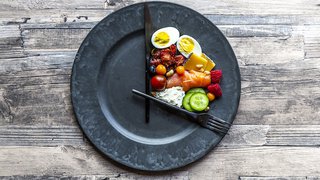Farm to table: Rediscovering a simple, practical approach to food
June 20, 2019

My grandmother never scoured the Internet for recipe ideas. She hasn’t read any diet books. She grew up on a farm and rarely bought food at a grocery store, except for flour and sugar for the occasional treat.
Those were simpler times, of course. They raised chickens, milked their own cows, and grew most of their own fruits and vegetables. They made meals at home and ate real food naturally full of nutrients and health benefits.
But our diets have shifted dramatically over the years, and what used to be a farm-to-table approach to eating has become factory to fast-food window. We gobble unhealthy food on the go, then feel guilty about it and dive head-first into the latest fad diet. When that doesn’t work, we overeat to deal with the disappointment.
Many people simply give up on the notion of “eating right.”
This dynamic has created a dysfunctional and potentially dangerous relationship between us and what we eat. An unhealthy diet has become the No. 1 risk factor for premature death in the U.S., according to recent research.
For solutions, Americans might consider looking back to the simpler times.
'Our diets have shifted dramatically over the years, and it has created a dysfunctional and potentially dangerous relationship between us and what we eat.'
Jaclyn Albin, M.D.
Author and journalist Michael Pollan writes in his book In Defense of Food, “Eat food. Not too much. Mostly plants. That, more or less, is the short answer to the supposedly incredibly complicated and confusing question of what we humans should eat in order to be maximally healthy.”
In modern times, that approach can seem next to impossible. But it’s not. Consider adopting these simple strategies to improve your relationship with food and create a formula for eating smart that suits your lifestyle.
5 ways to build a better relationship with food
1. Cook more food at home. Seriously. This has to happen. The best food is prepared at home with simple, colorful ingredients. So start small. Pick one or two healthy recipes that sound appealing – I’m currently loving these, Summer Quinoa Salad with Lemon Shrimp and Yellow Vegetable Curry – and over time, you’ll find yourself wanting to eat most of your meals at home.

2. Plan meals before you shop. This goes hand-in-hand with cooking at home. It may take a little extra time to create a healthy meal plan, but it will save you time and money at the grocery store because it won’t be a free-for-all of whatever sounds appealing at the moment. Consider, also, keeping a dry-erase board on the refrigerator to list the week’s meal plan. It will serve as a motivator and reminder. In my home, we make large portions for dinner most nights so we can have leftovers for lunch the next day or freeze some for a particularly busy week.
3. Eat more plants. The term “plant-based” is in vogue, and for most, it is another term for veganism. I’m not telling you to be a vegan, and nutrition science doesn’t tout the superiority of any one-size-fits-all approach to eating. But it does tell us that one of the most important things we can eat for our wellness is plants. In fact, research shows the risk of early death decreases with each increase in servings of fruits and vegetables daily. So, how do you do this? Some patients tell me they hate vegetables. You start small. If you normally put sausage on your eggs, try using salsa instead. (Yes, I just told you salsa is a vegetable). If you enjoy oatmeal, add whichever fruit you like to it. If you don’t enjoy a certain vegetable raw, try it steamed or roasted. Or move on to another vegetable. In young children, studies show that it often takes up to 15 trials of a new food before acceptance!
4. Eat with others. Meals are meant to be shared. Sometimes our busy schedules prevent this, but there are creative ways to share meals. Invite neighbors over, or even try Skype or FaceTime with family who don’t live nearby. When we eat with others, we tend to eat slower and balance our food consumption with conversation, laughter, and engagement.
5. Don’t be afraid of any macronutrient. Back to my grandmother. I don’t think she ever considered which carbs or proteins or fats to eat. This is another thing we have made entirely too complicated. Eat healthy fats, such as avocado, nuts (in moderation; 1/4 to 1/3 cup a day), and olive oil. Eat protein, of course, but avoid processed meats. You can choose between beans, nut butters, quinoa, eggs, yogurt, fish, or lean meats. Please don’t cut out carbohydrates entirely. Increasing whole grains and aiming for at least 3 servings of fruit per day are excellent health choices.
Dietary change is not just about removing the harmful foods, but blending culture, nutrition, and pleasure in a way that guides you to better wellness and a healthy relationship with your food.
If you or a loved one is interested in modifying your diet and eating habits, you can request an appointment online or call 214-645-8300.











